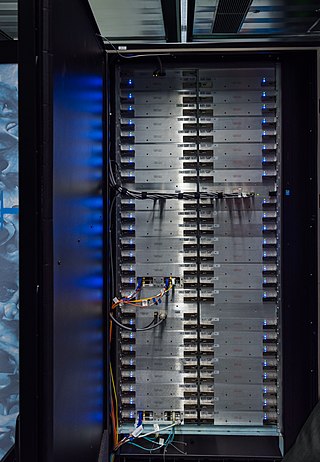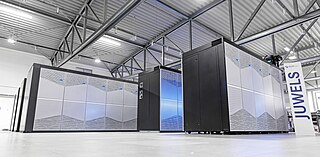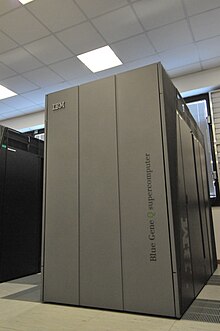
A supercomputer is a type of computer with a high level of performance as compared to a general-purpose computer. The performance of a supercomputer is commonly measured in floating-point operations per second (FLOPS) instead of million instructions per second (MIPS). Since 2017, supercomputers have existed which can perform over 1017 FLOPS (a hundred quadrillion FLOPS, 100 petaFLOPS or 100 PFLOPS). For comparison, a desktop computer has performance in the range of hundreds of gigaFLOPS (1011) to tens of teraFLOPS (1013). Since November 2017, all of the world's fastest 500 supercomputers run on Linux-based operating systems. Additional research is being conducted in the United States, the European Union, Taiwan, Japan, and China to build faster, more powerful and technologically superior exascale supercomputers.
Floating point operations per second is a measure of computer performance in computing, useful in fields of scientific computations that require floating-point calculations.

Blue Gene was an IBM project aimed at designing supercomputers that can reach operating speeds in the petaFLOPS (PFLOPS) range, with low power consumption.

High-performance computing (HPC) uses supercomputers and computer clusters to solve advanced computation problems.

EPCC, formerly the Edinburgh Parallel Computing Centre, is a supercomputing centre based at the University of Edinburgh. Since its foundation in 1990, its stated mission has been to accelerate the effective exploitation of novel computing throughout industry, academia and commerce.

The TOP500 project ranks and details the 500 most powerful non-distributed computer systems in the world. The project was started in 1993 and publishes an updated list of the supercomputers twice a year. The first of these updates always coincides with the International Supercomputing Conference in June, and the second is presented at the ACM/IEEE Supercomputing Conference in November. The project aims to provide a reliable basis for tracking and detecting trends in high-performance computing and bases rankings on HPL benchmarks, a portable implementation of the high-performance LINPACK benchmark written in Fortran for distributed-memory computers.

Distributed European Infrastructure for Supercomputing Applications (DEISA) was a consortium of major national supercomputing centres in Europe. Initiated in 2002, it became a European Union funded supercomputer project. The consortium of eleven national supercomputing centres from seven European countries promoted pan-European research on European high-performance computing systems by creating a European collaborative environment in the area of supercomputing.
Exascale computing refers to computing systems capable of calculating at least "1018 IEEE 754 Double Precision (64-bit) operations (multiplications and/or additions) per second (exaFLOPS)"; it is a measure of supercomputer performance.
The Swiss National Supercomputing Centre is the national high-performance computing centre of Switzerland. It was founded in Manno, canton Ticino, in 1991. In March 2012, the CSCS moved to its new location in Lugano-Cornaredo.
Eurotech is a company dedicated to the research, development, production and marketing of miniature computers (NanoPCs) and high performance computers (HPCs).
Supercomputing in India has a history going back to the 1980s. The Government of India created an indigenous development programme as they had difficulty purchasing foreign supercomputers. As of June 2023, the AIRAWAT supercomputer is the fastest supercomputer in India, having been ranked 75th fastest in the world in the TOP500 supercomputer list. AIRAWAT has been installed at the Centre for Development of Advanced Computing (C-DAC) in Pune.

Japan operates a number of centers for supercomputing which hold world records in speed, with the K computer being the world's fastest from June 2011 to June 2012, and Fugaku holding the lead from June 2020 until June 2022.

Several centers for supercomputing exist across Europe, and distributed access to them is coordinated by European initiatives to facilitate high-performance computing. One such initiative, the HPC Europa project, fits within the Distributed European Infrastructure for Supercomputing Applications (DEISA), which was formed in 2002 as a consortium of eleven supercomputing centers from seven European countries. Operating within the CORDIS framework, HPC Europa aims to provide access to supercomputers across Europe.
The HPC-Europa programmes are European Union (EU) funded research initiatives in the field of high-performance computing (HPC). The programmes concentrate on the development of a European Research Area, and in particular, improving the ability of European researchers to access the European supercomputing infrastructure provided by the programmes' partners. The programme is currently in its third iteration, known as "HPC-Europa3" or "HPCE3", and fully titled the "Transnational Access Programme for a Pan-European Network of HPC Research Infrastructures and Laboratories for scientific computing".

The Cray XC40 is a massively parallel multiprocessor supercomputer manufactured by Cray. It consists of Intel Haswell Xeon processors, with optional Nvidia Tesla or Intel Xeon Phi accelerators, connected together by Cray's proprietary "Aries" interconnect, stored in air-cooled or liquid-cooled cabinets. The XC series supercomputers are available with the Cray DataWarp applications I/O accelerator technology.

Fermi is a 2.097 petaFLOPS supercomputer located at CINECA.

Galileo is a 1.1 petaFLOPS supercomputer located at CINECA in Bologna, Italy.
The European High-Performance Computing Joint Undertaking is a public-private partnership in High Performance Computing (HPC), enabling the pooling of European Union–level resources with the resources of participating EU Member States and participating associated states of the Horizon Europe and Digital Europe programmes, as well as private stakeholders. The Joint Undertaking has the twin stated aims of developing a pan-European supercomputing infrastructure, and supporting research and innovation activities. Located in Luxembourg City, Luxembourg, the Joint Undertaking started operating in November 2018 under the control of the European Commission and became autonomous in 2020.

JUWELS is a supercomputer developed by Atos and hosted by the Jülich Supercomputing Centre (JSC) of the Forschungszentrum Jülich.

Leonardo is a petascale supercomputer located at the CINECA datacenter in Bologna, Italy. The system consists of an Atos BullSequana XH2000 computer, with close to 14,000 Nvidia Ampere GPUs and 200 Gbit/s Nvidia Mellanox HDR InfiniBand connectivity. Inaugurated in November 2022, Leonardo is capable of 250 petaflops, making it one of the top five fastest supercomputers in the world. It debuted on the TOP500 in November 2022 ranking fourth in the world, and second in Europe.














